Jesper Juul's Blog, page 3
November 22, 2024
The History of the Commodore 64 in Twelve Objects #4: Impossible Mission and Tapes
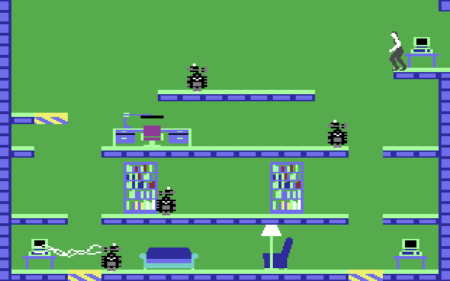 On the occasion of my upcoming book Too Much Fun: The Five Lives of the Commodore 64 Computer, I am writing The History of the Commodore 64 in Twelve Objects, posted weekly from November 1st, 2024:
On the occasion of my upcoming book Too Much Fun: The Five Lives of the Commodore 64 Computer, I am writing The History of the Commodore 64 in Twelve Objects, posted weekly from November 1st, 2024:
“Another Visitor. Stay a while, stay forever!“
The hammy voice of the evil scientist greets the player. The 1984 Impossible Mission by Dennis Caswell at Epyx was a technical marvel when it came out.
The “Another Visitor” sample and the “Destroy Him by Robots!” sample were shocking because the Commodore 64 did not have any facility for playing sampled sound. The sample was played by quickly changing the volume of the sound chip, creating clicks of different volume. The animation, based on pictures from a book about athletics, was fluid and expressive, combining multiple high-resolution sprites of different color.
Sound and graphics were amazing and high tech, exploiting and showcasing your C64’s abilities, making it the game you would show visiting friends to cement that yes, the C64 was the most advanced game platform.
The game, on the other hand, was painfully difficult. You die constantly by falling down, running out of time, or merely grazing an enemy robot. This was normal. Yet Impossible Mission was also inspired by Rogue, and the layout of the levels was randomized at every playthrough, which did not really become mainstream until the release of Spelunky in 2008.
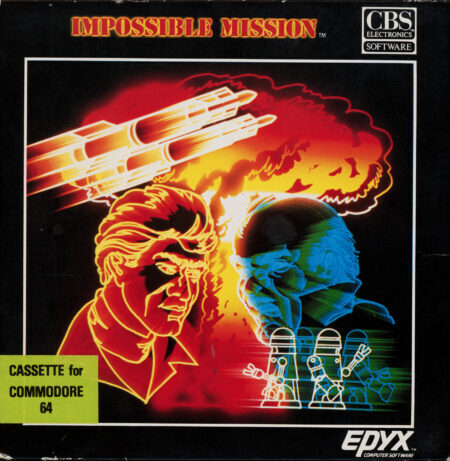
Impossible Mission came on tapes or floppy disks. The exciting-looking box evoked sci-fi and the cold war and the pictures were – as everybody understood – nothing like the actual game. Inside the box was a manual, as was the custom, and the tape itself.
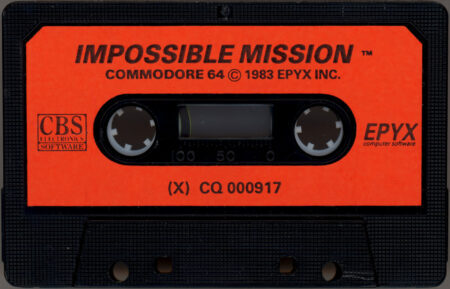
To play the game, you’d put the tape into Commodore Datasette deck, rewinding the tape before typing “LOAD” and pressing play.
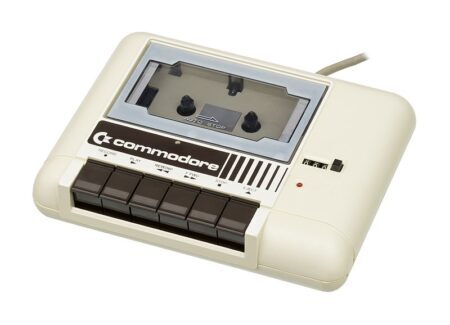
(Photo by Evan-Amos, public domain).
Most users also had stacks of regular audio tapes onto which pirated software had been recorded, and the little counter on the Datasette was paramount for finding the location where the game was stored, noting the location on the tape inlay. If you had a tape deck, you would do this a lot.
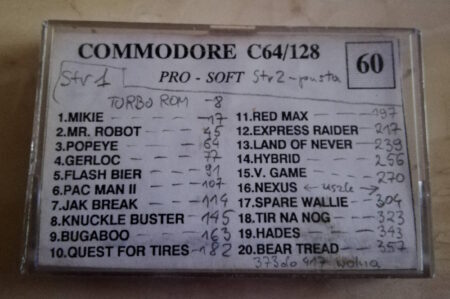
(Imgur)
Some radio stations even broadcast C64 programs on air, giving a wall of modem-like screeches to be recorded on a regular tape recorder, and then inserted in the Datasette.
What are your memories of games and tapes?
Coming November 29th: Object #5 – Zzap!64 and other magazines.
November 15, 2024
The History of the Commodore 64 in Twelve Objects #3: “We promise you won’t use the Commodore 64 more than 24 Hours a Day” – advertising
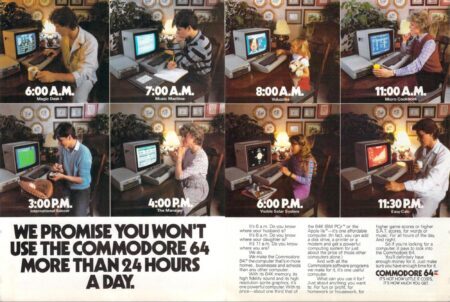
Who is the Commodore 64 for? In the 1985 ad “We Promise you won’t use the Commodore 64 More than 24 Hours a Day”, the Commodore 64 is for the whole family, divided into familiar roles, and the machine guarantees the family’s safety and unity. Research assistant Laurel Carney at MIT pointed out that the text, “It’s 8 a.m. Do you know where your daughter is”, echoes a 1960s-80s US public service announcement scaring parents to keep tabs on the whereabouts of their children, “Do you know where your children are?” In the ad, worries about safety speaks for getting a computer – because the computer is so addictive, the whole family will be kept safely home, with dad (who seems to get very little sleep) doing both office work and stocks, the son playing games and doing homework, the younger daughter solving puzzles, the elder daughter studying the solar system, and mom looking up recipes and managing the household with a database.
Though Commodore lacked a global advertising strategy and left it to individual countries come up with their own, there was an early global pattern of focusing on the serious side of the C64, and only mentioning games as an aside.
Compare the previous ad to this: The most referenced ad today is probably the Australian “Are you Keeping up with the Commodore”, famous for its catchy jingle, the implied threat that you may will fall behind if you don’t have the computer, and the bizarre hand gesture from the C64 users.
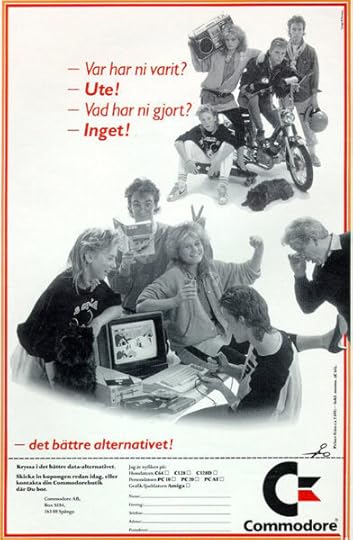
In many European countries, Commodore gradually accepted the machine’s status as a game computer and began to advertise it as such. This circa 1987 Swedish ad makes fun of apparently delinquent youths. “Where have you been? Out. What did you do? Nothing,” with the C64 being the better alternative, young people enjoying playing video games together. The acceptance of games also made it into the C64 packaging, sometimes themed around bundled games like Batman.
Computer ads also have the feature that the dedicated computer owner – like me! – liked the ads because it said positive things about your computer in a public space. I did feel aligned with the Commodore company at the time and wanted to see more and better C64 ads.
What ads inspired you?
The full history is here: https://www.jesperjuul.net/c64/history/#obj3
Coming November 22nd, Object #4: Impossible Mission
November 8, 2024
The History of the Commodore 64 in Twelve Objects #2: 10 PRINT “HELLO”
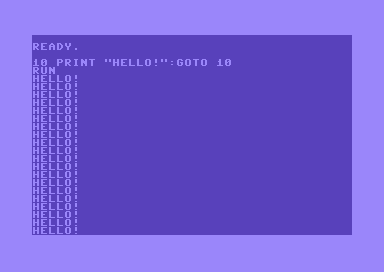 On the occasion of my upcoming book Too Much Fun: The Five Lives of the Commodor 64 Computer, I am writing The History of the Commodore 64 in Twelve Objects, posted weekly from November 1st, 2024:
On the occasion of my upcoming book Too Much Fun: The Five Lives of the Commodor 64 Computer, I am writing The History of the Commodore 64 in Twelve Objects, posted weekly from November 1st, 2024:
Turning on the Commodore 64 launches us into a comforting interface in dark and light blue colors. It is a machine where interface, programming, and housekeeping take place using the same BASIC programming language. We can type immediate commands such as:
?10+20
20
READY
BASIC (Beginner’s All-Purpose Symbolic Code), originally developed by John Kemeny and Thomas Kurtz at Dartmouth College in the early 1960s, was designed to make computing universally accessible, at first for Dartmouth students. BASIC became a central platform for games in the 1960s and 1970s, and David Ahl’s book BASIC Computer Games (1973) compiled and distributed the games made in computer labs on paper, the only viable form of mass-market program distribution of the time. One central early aspect of Commodore 64 culture was to type in pages and pages of programs from manuals, magazines, and books.
I think a core joy of programming is that we can make the computer do sustained work for us. The Commodore 64 User’s Guide coming with the machine encourages us to make a program printing “COMMODORE 64”, but the text was almost always the user’s name.
10 PRINT “HELLO!”:GOTO 10
Try making your own 10 PRINT program on the book’s website:
https://www.jesperjuul.net/c64/history/#obj2
Coming November 15th, Object #3: “We Promise You Won’t Use the Commodore 64 More than 24 Hours a Day” – Commodore 64 ads
November 1, 2024
The History of the Commodore 64 in Twelve Objects #1: The Commodore 64 itself
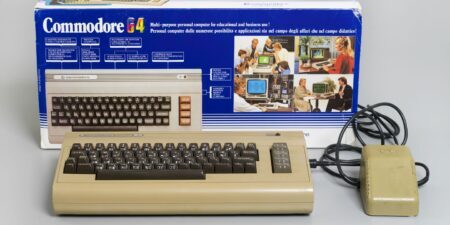
The most popular computer, yet often forgotten. Why?
On the occasion of my upcoming book Too Much Fun: The Five Lives of the Commodor 64 Computer, I am writing The History of the Commodore 64 in Twelve Objects, posted weekly from November 1st, 2024:
Object #1: The Commodore 64 itself, known affectionately as the breadbox for its shape. Launched in 1982, following the Commodore company’s successful VIC-20 computer (1980). At 12,5 million units sold, the C64 was by far the best-selling home computer of the era, and it was also the platform with the most video games from 1985 to 1993 – 5,500 games are known.
But there is a mystery: there are both computer and video game histories that never mention the machine. My new book tries to find out why. I have tried to write the best book I could about the C64, but this was also my own first computer, and revisiting it has been thrilling and full of surprises.
The C64’s longevity went beyond any expectation – home computers were known to have a short life span, and already in 1983 Sierra game developer Ken Williams was spreading the rumor that production was about to cease, yet the machine was produced until 1994.
Strangely, none of its three central chips were originally designed for a computer. The 6510 (6502) CPU was originally planned for control systems, the SID sound chip was designed for synthesizers, and the VIC-II graphics chip was originally planned for video game devices. This became the C64, combining state-of-the art graphics and sound with strange flaws, such as a limited BASIC programming language and slow tape and disk drive.
Though Commodore never updated the machine functionally, users and developers fixed its flaws and kept finding new ways to use it. In the book, I call this the five lives of the machine. The European box shows the first life – a serious computer for work, studying, and the home, and for programming in BASIC.
More about Too Much Fun: The Five Lives of the Commodore 64 Computer here: https://mitpress.mit.edu/9780262549516/too-much-fun/
Next week: Object #2, 10 PRINT “HELLO”: GOTO 10
What are your memories of the Commodore 64?
October 2, 2024
PhD opportunity in practice-based research
At the Royal Danish Academy, we are inviting applications for prequalification for an upcoming fellowship opportunity: the Novo Nordisk Foundation’s 2025 Mads Øvlisen PhD fellowships in art history and practice-based research.
There is definitely a possibility of a game-related Phd project, for example one that combines game-making and research, or a curatorial one.This is a two-step process where applicants first need to send a short project outline, and if approved it gets developed into a full application in collaboration with us.Follow the link for more info or email me.https://candidate.hr-manager.net/ApplicationInit.aspx?cid=5001&ProjectId=183096&DepartmentId=7810&MediaId=5October 1, 2024
Too Much Fun: The book cover
And we have a cover for my upcoming book (December 10th, 2024). https://mitpress.mit.edu/9780262549516/too-much-fun/

July 10, 2024
Pre-Order Promotion for my upcoming book Too Much Fun: The Five Lives of the Commodore 64 Computer
Barnes & Noble is running a Flash Pre-Order Promotion including my upcoming book Too Much Fun: The Five Lives of the Commodore 64 Computer.
From July 10-17, get 25% off with the code PREORDER25 at checkout!
https://www.barnesandnoble.com/w/too-much-fun-jesper-juul/1144883719?ean=9780262549516
July 4, 2024
My upcoming book, Too Much Fun: The Five Lives of the Commodore 64 Computer
I am happy to announce that I have finished the page proofs for my new book, Too Much Fun: The Five Lives of the Commodore 64 Computer. Coming on November 12th, 2024. Feel free to preorder!
I will post more as we get closer to the publication date.
https://mitpress.mit.edu/9780262549516/too-much-fun/
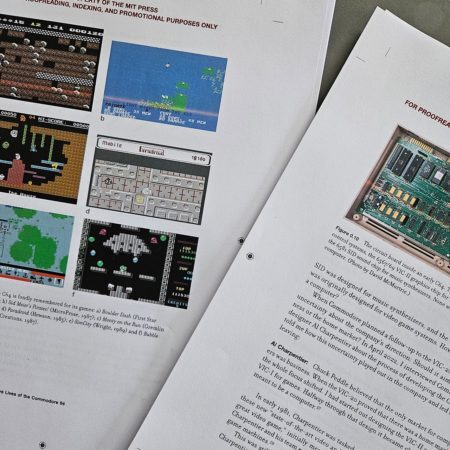
April 11, 2024
The Rule Book: The Building Blocks of Games
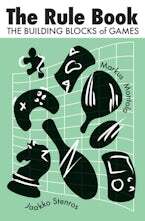 Presenting The Rule Book: The Building Blocks of Games by Jaakko Stenros and Markus Montola. Out now on MIT Press in the Playful Thinking series.
Presenting The Rule Book: The Building Blocks of Games by Jaakko Stenros and Markus Montola. Out now on MIT Press in the Playful Thinking series.
How games are built on the foundations of rules, and how rules—of which there are only five kinds—really work.
Board games to sports, digital games to party games, gambling to role-playing games. They all share one thing in common: rules. Indeed, rules are the one and only thing game scholars agree is central to games. But what, in fact, are rules? In The Rule Book, Jaakko Stenros and Markus Montola explore how different kinds of rules work as building blocks of games. Rules are constraints placed on us while we play, carving a limited possibility space for us. They also inject meaning into our play: without rules there is no queen in chess, no ball in Pong, and no hole in one in golf.
Stenros and Montola discuss how rules constitute games through five foundational types: the explicit statements listed in the official rules, the private limitations and goals players place on themselves, the social and cultural norms that guide gameplay, the external regulation the surrounding society places on playing, and the material embodiments of rules. Depending on the game, rules can be formal, internal, social, external, or material.
By considering the similarities and differences of wildly different games and rules within a shared theoretical framework, The Rule Book renders all games more legible.
February 26, 2024
Visual Game & Media Design application deadline March 1st!
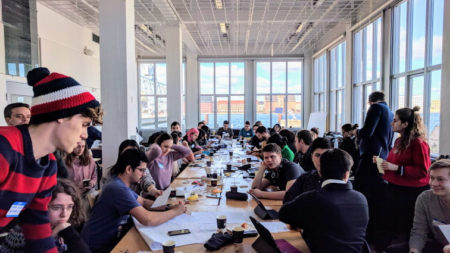 Please join us for our Visual Game & Media Design two-year master’s program in Copenhagen!
Please join us for our Visual Game & Media Design two-year master’s program in Copenhagen!
The application deadline is March 1st.
Read more about the program here:
https://royaldanishacademy.com/programme/visual-game-and-media-design



